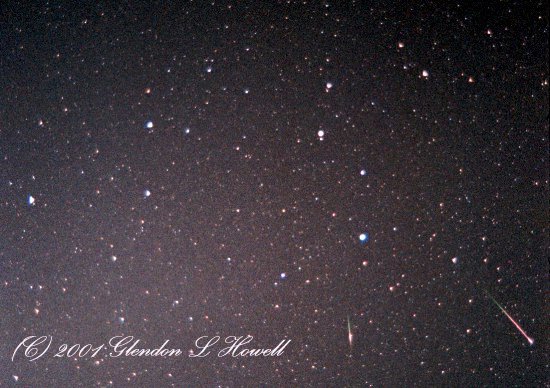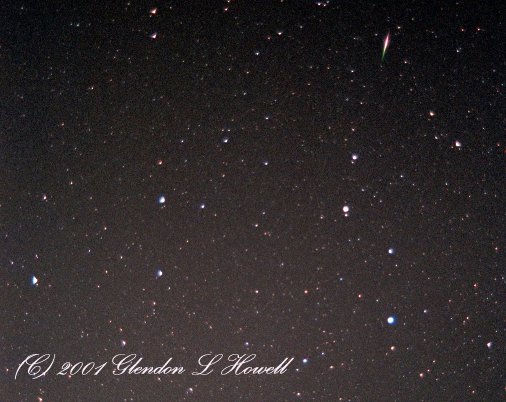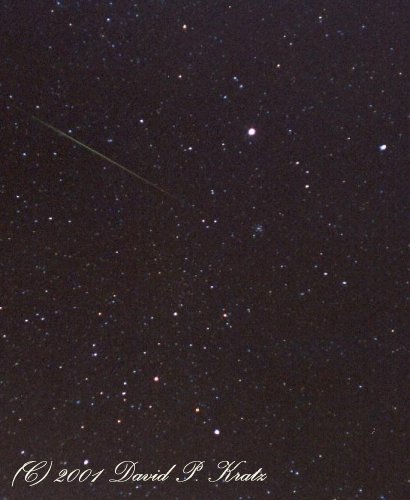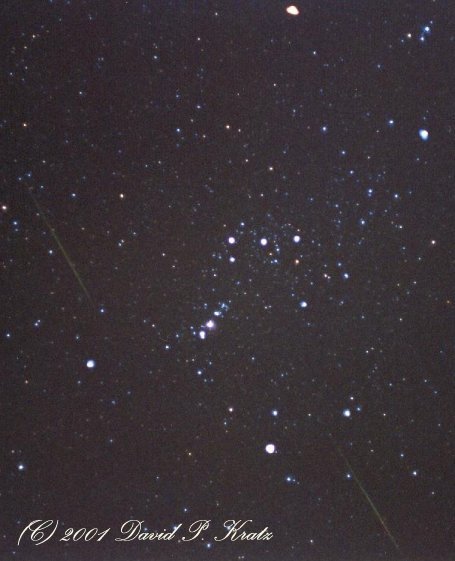
The Great Leonid Meteor
Shower of 2001
By Kent Blackwell
Reprinted from the December 2001 issue of "Norfolk Skies", the Official Newsletter of the Norfolk Astronomical Society
November 17 2001, a day marked on many amateur calendars throughout the world. On this day it was hoped one would witness the great Leonid meteor storm. Last year, and the year before the storm failed to match the incredible display of 1966. Still, in 1999 many people saw a great number of Leonids, including marvelous fireballs. Due to clouds in the area, I wasn't fortunate enough to be among those. The year 2000 was a disappointment completely, but many experts predicted 2001 would prove a good year for the Leonids. Their predictions were completely accurate.
Saturday, November 17 started a beautiful day in Coinjock, NC.
I had my site picked out, cameras ready, and reclining lounge
chair in place; in short, I was prepared to view and photograph
the event. But then something unpredictable happened, clouds rolled
in from off shore. Hoping they were only temporary I waited it
out. By nightfall the clouds still remained. At 7:00 pm Glen Howell
called from his observing site in Gates County, NC, indicating
the sky was clear. Rather than take a chance I packed up my equipment
and headed westward to Gates County.
Driving through Elizabeth City and then Suffolk the clouds lingered.
It was not until approaching the western portion of Suffolk that
it began to clear. Upon reaching Gates County there wasn't a sign
of a single cloud in the sky. Thank goodness I had escaped the
clouds. Incidentally, I learned it eventually cleared in Coinjock,
and in fact all of the Tidewater, VA area. Friends on the Outer
Banks of North Carolina reported the skies remained cloudy until
3:00 am.
After arriving at Glen's site Wesley Jacocks and Dr. Richard Harmon
joined me. Each of us unloaded our vehicles, set up tents and
laid out lounge chairs to prepare for an evening of meteor watching.
I must admit my prediction of the event was a bit less optimistic
than many. Last year's Leonids was a disappointment, and though
1999 was good, the number of meteors fell far short of predictions.
By 10:00 pm we began seeing occasional Leonids. Mixed in were
a few sporadic meteors, as well as a number of Taurids. How interesting
it was to see the Leonids flying across the sky in one direction
and the Taurids in the other. Several amateurs have since nicknamed
these Taurids, "anti-Leonids".
I purposely did not take a telescope, knowing full well had I
done so I'd be peering through the eyepiece and miss every single
meteor. I did, however take along a pair of 10x30 Canon stabilized
binoculars. It was a treat to lay back and look at the Milky Way
with these. An added treat was viewing Comet C/2000 WM Linear
in the binoculars, as well as in Glen's 8" f/6 Newtonian
and Wesley's new 5" Maksutov-Cassegrain telescope. Ever so
often I'd get up from my comfortable chair to peer through one
of the telescopes at such delights as the Veil Nebula, the North
American Nebula, and of course the Great Orion Nebula. It was
the best I've ever seen it.
Midnight came, then 1:00 am. Pretty soon the 3:00 am hour was
approaching and we were seeing more and more brilliant Leonids
sail across the sky in every direction. At 4:00 am I called Chesapeake
Planetarium director Dr. Robert Hitt to advise him to go outside
and look at this fantastic meteor display. I later learned even
from his city observing location in Virginia Beach he was able
to see about 15 meteors per minute. I also learned his 93-year
old mother laid out on a recliner from 4:30 am until sunrise.
She surely has to be one of the oldest persons to have witness
the event.
At our remote site in North Carolina we lost count of the meteors,
but estimated an average of 1 per second, or about 3600/hr. I've
just never seen anything comparable to it. How can anyone who
saw the Leonid display of 2001 be impressed with an average meteor
shower again?
By 4:30 am Glen's daughter and mother joined us. His father made
it out of the house but I never saw him. I surely hope a Leonid
didn't strike him on his way to the observing field. All of us
were in awe at the vast number of meteors as dawn approached.
Even as the sun rose we could still see vapor trails.
As the sun brought the event to a close I envied those in Australia
who would have their opportunity to see the meteor storm at 1:00
pm, our time. Unfortunately, some of the people with whom I have
communicated in Australia have said clouds prevented any observational
programs. So, it appears the east coast proved to be one of the
best areas in the country, maybe even the world. Much of the western
portions of Virginia and Maryland were hampered by fog an hour
before dawn, so those missed out on the peak of the storm. We
were very lucky in the immediate Tidewater, VA area to have such
exemplary weather.
Those who know me know I usually miss every meteor in the sky,
simply because I can't take my eye away from the eyepiece of a
telescope. I'll have to say thank you to my friends who insisted
I not listen to my own instincts of predictions for this shower.
To those friends I am indebted, for I have witnessed the greatest
meteor shower in a lifetime.

The Leonid Storm of November 18, 2001. Glendon Howell captured these 2 meteors in just a couple of minutes exposure pointed at the radiant on Fujicolor Super G 800 Plus film and a 30-70mm zoom at its 30mm setting. The original uncropped image has a total of 5 meteors recorded!

Identifying The Leonid Radiant. From these two photos, it is fairly easy to trace the origin point (the radiant) back to the rear of the "backwards question mark" of the head of Leo. Glendon Howell captured this meteor in just a couple of minutes exposure pointed at the radiant on Fujicolor Super G 800 Plus film and a 30-70mm zoom at its 30mm setting. It is interesting to note that the 1833 Leonid Storm with its estimated 150,000 meteors per hour was the first time meteor shower radiants were recognized. Prior to that time it was believed meteors came through the atmosphere randomly. Radiants are caused by the fact that the meteors of the shower are entering the atmosphere moving parallel to each other and only appear to go different directions due to perspective. Their paths appear to converge at the radiant much as parallel railroad tracks appear to converge with distance.

Photographing Longer Meteor Trains. Photographing directly toward the radiant records only short trail meteors as the meteors are coming near directly toward the observer. To record the longest trails, the camera needs to be pointed about 40 degrees away from there. Member Dave Kratz recorded this meteor passing through the constellation Canis Major using a 50mm lens and ISO 400 speed film. The bright star toward the top center is Sirius, the Dog Star.

Leonids Spear The Hunter. In a single exposure, Dave Kratz records two meteors flashing through the constellation Orion, the Hunter. Note how parallel the meteors are in their direction of motion. All meteors belonging to this shower will trace backward to the Leo radiant. Those that do not belong perhaps to other showers also going on like the Taurids. Meteors that can not be identified as members of any specific shower are termed "sparodics".
Look for more photography by these NAS members on the following sites:
Dave Kratz's Radiative Transfer Homepage
Look for other great Leonid photos by the following great astrophotographers on their websites:
Tony Hallas - http://www.astrophoto.com/meteor.htm
Tom Polakis - http://www.psiaz.com/polakis/leonids2001/leonids2001.html
Jerry Lodriguss - http://www.astropix.com/HTML/SHOWCASE/LEONID3.HTM
--- GLH 12/04/2001